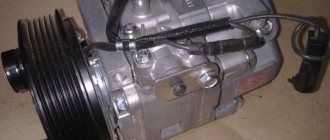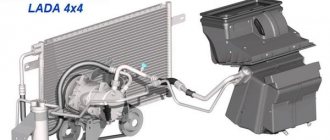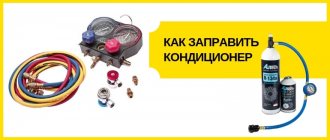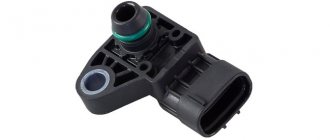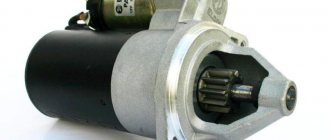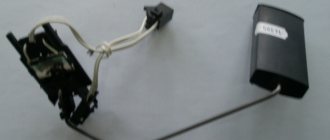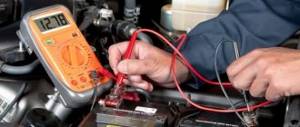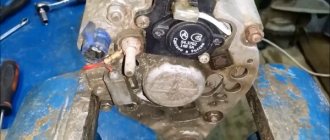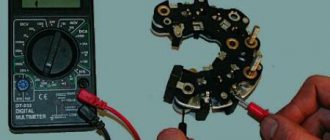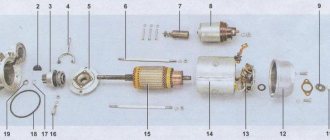Do you think that the air conditioner does not cool the interior enough in hot weather, does not cope with its task 100% and the air coming from the air ducts is not as cold as you would like? Do not rush to seek help from specialists; first check the efficiency of the air conditioner yourself.
The air conditioning device on all modern LADA cars (XRAY, Vesta, Largus, Granta, Priora, Kalina and Niva 4x4) has no fundamental differences. Therefore, checking its operation is carried out in a similar way. The instructions will also be useful for owners of cars of other brands.
How to check an air conditioner radiator
The condenser (air conditioning radiator) is located in front of the radiator of the engine cooling system. During operation, especially in the summer, it becomes dirty (dirt, midges, fluff, etc.). This leads to a decrease in heat transfer, and as a result, to a decrease in the efficiency of the air conditioner (barely cool air blows).
Checking the condition of the air conditioner radiator comes down to a visual inspection. We inspect it through the lower radiator grille. If it is very dirty, clean the radiator from dirt with compressed air (pressure no more than 3 bar) or with a brush.
Checking the performance of a used air conditioner
Older models are sold in good condition if they have been cared for regularly. But it happens that a defective model was purchased, which works below the declared power or with malfunctions that the technicians could not fix.
To find out if the air conditioner is working, connect both units to each other. It is not necessary to hang them on the wall - just connect the copper pipes of the two units and connect the electrical wires. The operation of the device is assessed by the noise level, the cooling time of the room, and the operation of all functions. It is better to entrust the inspection procedure to a specialist who understands climate control technology and will give his opinion.
When purchasing an air conditioner, you should check the following parameters:
- electricity consumption;
- pressure in the system (by manifold);
- compressor temperature;
- current.
Tools for checking are available in the specialist’s arsenal. If you save on a purchase, it is advisable not to skimp on inspection.
How to check the evaporator
The evaporator is located under the panel in the car interior (in the air conditioning unit). Access to it is difficult. If the evaporator is very dirty, then after turning on the air conditioner, an unpleasant odor will be felt in the cabin. You can clean the evaporator at a specialized service station or yourself.
DIY car air conditioner diagnostics
Buying a used car is associated with the risks of purchasing a car, which in the future will make “life together” unbearable. Today we will touch upon such an issue as diagnosing a car air conditioner with your own hands or determining whether the car air conditioner is working independently in a car. Everyone knows that repairs and diagnostics of a car air conditioner can cost several tens of thousands of rubles. The best option to check it is to send the car to a car service center for diagnostics of the car air conditioner . But, unfortunately, this is not always possible, and you won’t send every car you like to specialists.
The first thing you should do to independently assess the operation of a car air conditioner is to let the seller know about its performance. If you receive an answer that the air conditioner works in principle, but it only needs to be refilled, or the freon was released for the winter, or other fantastic stories, it is worth studying this issue in more detail, to understand the principle of operation of the car air conditioner. You can also start haggling on the price, since repairs and diagnostics of the car air conditioner will have to be carried out. Next, we begin to independently determine whether the air conditioner is working. Please note that a lit button in the cabin about the operation of the car air conditioner cannot guarantee that it really works.
So, let's start, the air temperature should be plus 15, then we press the button to turn on the air conditioner and listen carefully. There should be a click in the hood, this indicates that the compressor has started working. There are cars that also turn on additional radiator fans. There is also an option, ask the owner to press the start button of the air conditioner, and under the hood watch the start of the compressor, to be precise, the part that is responsible for rotating the belt. If the engine is running, then only the compressor pulley rotates, and the compressor end element is stationary. When the air conditioner is turned on, the plate is magnetized to the pulley itself, this creates a click. If all this action occurs correctly, then we can conclude that the air conditioner turns on. But there are types of cars in which the pressure plate is constantly on in the compressor, and the work of turning on the air conditioning takes place inside the housing. It happens that it is difficult to see all this action due to the location of the parts in the engine compartment.
Be sure to find the air conditioning pipes and radiator in the engine compartment. There were simply cases when a button with a snowflake was installed in a car, at a time when there was simply no air conditioning in the car.
Let's consider a car air conditioning radiator ; it is located in front of the engine cooling radiator at a very close distance. Both radiators are usually about the same size and you can often think that one radiator is the main one, but if you look closely from the headlights, you can tell them apart. Also, the engine radiator has plastic tanks, while the air conditioner radiator has either copper or aluminum tanks.
We are trying to find and go through the entire air conditioning system . We start again from the compressor; a tube about 1 cm thick should go from it to the air conditioner radiator. This is a pressure line. Next, we look at the outlet from the radiator, the tube should be thinner, it will lead to the receiver drier (this does not exist on all types of cars). It looks like a vertical barrel up to 10cm in diameter. There may be an inspection hatch on top of this barrel. We go further along the tube, which should lead to the salon; it is possible that it will go a long way. A refill port may be located on this tube.
We are looking for a return line, this tube should be quite thick, about 2 cm in diameter. It connects the air conditioner structural elements located in the cabin with the compressor.
Once we have identified all the elements and formed a picture of the structure and operation of the car air conditioner , we proceed to a simple self-diagnosis of the system’s operation.
When turning on the air conditioner, you need to grasp the metal part of the return line, not the hose - with your whole palm. After 10 seconds, the hand should feel a strong cold, the cold should be so intense that even the bones on the hand begin to freeze. The cold will come in waves, this is normal.
Try, only very carefully, the metal pressure pipe that goes from the compressor to the radiator. It should be hot, and if the weather is hot outside, it should get very hot.
Next, we touch the thinnest tube connecting the air conditioner radiator and the interior. It should be warm, but if it is so hot that you can’t pick it up with your hand, this symptom indicates a non-working fan, or a dirty radiator, or an overcharged system.
If the above signs indicate a discrepancy with the described characteristics, then you should send the car for diagnostics and refill the car air conditioner or simply refuse to buy it.
There are structurally slightly different types of air conditioners, when the receiver-dryer performs the additional function of a pre-evaporator. It is designed to prevent liquid freon from entering the compressor. Its standard location, on the return highway, is not small in size. When the air conditioner is running, this unit should become cold.
An effective way to check the performance of a car air conditioner is to take a thermometer, preferably an electronic one, and insert it with the sensor as deep as possible into the deflector. Turn on the air conditioner at full power and direct it to this deflector. If the temperature reaches 10 degrees Celsius, then the system is working properly, if the temperature reaches 5 degrees, then you have a very powerful air conditioner.
What else is worth paying attention to? All connections and pipes must be inspected. Fogging and oil stains on the tubes may be a sign of leaks.
Checking the air conditioner in winter.
If the street is below minus ten degrees, then it is not easy to check the operation of the car air conditioner; you may not understand whether it is working or not, due to the drop in refrigerant pressure at this temperature range. The following method can be applied to certain vehicles. It is necessary to warm up the interior of the car as much as possible so that the dashboard is hot. This is done so that the evaporator sensor located under the dashboard thinks that it is hot in the cabin, and the car air conditioner can be allowed to operate. But there are cars that do not allow the climate control system to work when the temperature sensor outside the car registers above plus 5, i.e. It will not be possible to enable the installation in this particular case.
You can help the air conditioner start by pressing the air recirculation button inside the cabin; some cars in this option become loyal to starting the car air conditioner during the cold period . After a successful launch, we proceed further and check the operation as described above.
Let's say that the described check of the operation and diagnostics of a car air conditioner with your own hands does not give a 100 percent diagnostic result, but allows you to draw intermediate conclusions and make the right decision about mandatory professional diagnostics, possibly even repairs, before purchasing a car.
And finally, a video about the principle of operation of a car air conditioner and compressor :
How to check the efficiency of your air conditioner
Required
: thermometer or thermometer.
Procedure
:
- Start the engine
- Turn on the air conditioner and set the temperature to the lowest setting.
- Set the maximum blowing speed.
- Set the direction of the air “in the face”.
- Insert the thermometer into the central air duct (deflector).
- Raise idle speed to 2000 rpm.
- We wait until the temperature on the thermometer stops dropping.
The process is also shown in the video:
We compare the data with this table:
If the temperature differs significantly from the data in the table, then it is necessary to look for the cause. One of the reasons for poor air conditioner performance is low refrigerant levels. Over the course of a year, even in a sealed system, the amount of freon can decrease by 15%.
Checking the air conditioner is also shown in the video:
Another way
described in the technological instructions:
- connect the service hoses to the fittings on the air conditioning system pipelines and open the valves at the hose tips;
- start and warm up the engine to operating temperature;
- set the air recirculation mode to the outside air intake position;
- turn on the heater fan motor and set the maximum rotation speed;
- open the central and side ventilation nozzles on the panel and set them to the neutral position;
- set the air conditioning switch to the “on” position and set the temperature regulator to the minimum value of the cabin air temperature;
- close all car windows and doors;
- ensure constant operation of the engine cooling system fan;
- set the engine crankshaft speed to 1500 rpm;
- measure the ambient temperature;
- wait 5 minutes and measure the air temperature from the side ventilation nozzles of the body;
- after stabilizing the values, determine the temperature difference between the outside air and the highest value of the air temperature from the ventilation nozzles;
If the temperature difference between the ambient air temperature and the highest temperature value from the ventilation nozzles is less than 5°C
– this means the system is faulty and it is necessary to diagnose the air conditioning system.
Have you checked the operation of your air conditioner this way?
Let us remind you that we leave reviews about the operation of the air conditioner and climate control of the Lada Vesta and XRAY here.
Photo: TimurShar in-flight magazine
Keywords: air conditioner Lada Granta | air conditioner Lada Kalina | air conditioner Lada Priora | air conditioner Lada Largus | air conditioning 4x4 | air conditioner Lada Vesta | air conditioner lada xray | air ducts Lada Vesta | air ducts lada xray | air ducts 4x4 | air ducts for Lada Granta | air ducts Lada Priora | air ducts Lada Kalina | air ducts Lada Largus | Niva air conditioner | Niva air ducts | universal article
2
0
Found an error? Select it and press Ctrl+Enter..
Modern devices
A refrigerant leak does not always lead to breakdowns and complete failure of the air conditioner. In fact, parts of the device will experience unusual effects and pressure only if there is absolutely no refrigerant in the system. The compressor will begin to experience overheating, and this is the “root of all evil.” In order to independently detect a leak, it is not necessary to have serious knowledge and tools.
First of all, you need to find out whether there is freon in the air conditioner, or whether it has all leaked out. Depending on this, you will need to choose a specific verification method. Above are two simple methods that allow you to independently check the tightness of the air conditioner.
Fortunately, technology does not stand still and not so long ago devices were developed that can “sense” freon in the air. This technique reacts to both freon and other types of gas. There is a special scale that shows the freon level. If its amount in the air reaches a certain threshold or even exceeds it, a signal sounds. In other words, there is no need to check the air conditioner for leaks if a special device is located next to it. You can purchase such equipment together with an air conditioning system, since they are often sold in one place.
To determine the immediate location of the leak, it is necessary to run this device throughout the entire pipeline system. As you approach the leak site, the signal will intensify. If there is a draft in the room, then the device can be misleading with its signal, since it will react to any gases coming from outside. It reacts especially brightly and quickly to exhaust gases.
